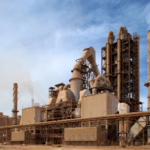Cement scrips have historically remained darling of the day traders as well as short-term investors. Long term investors also invest in selected cement manufacturing companies, having credible dividend payout history. Lately, cement manufactures have made massive investment due to two key factors: 1) capacity utilization hovering around 95% and 2) mega infrastructure projects being constructed under China Pakistan Economic Corridor (CPEC). Many equity analysts have been presenting a rosy outlook for the industry. However, a few have been raising caution marks to avoid the fallout of herd mentality.
One of the latest reports of AKD Securities highlights the adverse impact of two of recent phenomena: 1) hike in international price of coal and 2) substantial depreciation of PKR. Theoretically, depreciation of PRK should have boded well for exporters, but the hike in coal price eroded competitiveness of local cement manufacturers in the global markets.
Persistent hike in the input cost id squeezing margins every quarter. According to a report by AKD Securities, the gross margins of its cement picks has come down to as low as 26% by the end of 3QFY18 as compared to 37% for the corresponding period of FY17. In this regard, the sudden currency adjustment is another drag on margins that are already struggling on account of relentless increase in international coal prices reported at US$107/ton, up 32%YoY. After incorporating Pak rupee depreciation (average PkR/US$ parity now at 131.75, the brokerage house has revised gross margins downward by an average to 22.5% for FY19. Consequently, the earnings estimates go down by an average 15% for FY19.
With the recent hike in interest rate, higher debt servicing cost has become another dampener: With the anticipation of more and substantial interest rate hikes, debt servicing of the cement sector is likely t0 increase further. The current financial leverage of the sector (D/E: 35% in March 2018) owing to ongoing expansion cycle. The sensitivity analysis suggests bottom-line impact of 4-8% (FY19) on the top cement universe for every 100bps further hike in interest rate. In this regard, CHCC and DGKC being highly leveraged (D/E reached 50% by the end of March 2018) stand more exposed to interest rate hikes threats than the rest.
A positive point is that lately cement prices have posted decent recovery. With the recent price hike of Rs10/bag, cement prices in the Northern region have posted a decent recovery from Feb’18 (cumulative increase of Rs85/bag in North), where prices are now up by almost 2.5% since its peak in June 2017. Post recent price hike, analysts expect cement prices to remain at current levels for the remainder of the year. That said, pricing pressure can trickle down to the Southern region once DGKC’s expansion comes online, further dragging regional utilization to 65% by FY19 from 78% in FY18.
While the herd mentality of the sponsors, especially the big ones, is highly deplorable, financiers of these projects could also be held responsible as well as the government of Pakistan. It seems all were carried away by China Pakistan Economic Corridor (CPEC) mantra. This situation has not come up for the first time, historically, sponsors of cement plants, many of them also having majority stake in commercial banks or the capacity to dictate banks’ policies were too ambitious. Every time they tend to take into account the recovery plan, in case the first plan falters. It is that they have been operating as a very strong cartel, but the harsh reality is personal interest comes first.
In case of glut the worst sufferers are smaller units suffering from relatively high cost of production and lacking the power to pass on the hike in cost of production to buyers. It is on record that even the best performing cement manufacturing are seeking support from the government, in the shape of some subsidy to sell their cement to overseas buyers. In the process of nationalization, many of the textile tycoons have bought cement units by acquiring huge loans from the banks, a tactic commonly followed by the textile tycoons. Once a glut like situation is created, they start demanding subsidies for exports.
Low cost housing scheme
The government which hardly paid any heed towards construction of low cost housing projects has floated a draft of low cost housing scheme and soliciting public opinion. The preamble says, “Housing sector in various economies serves as an engine of economic growth. It has the potential to generate employment, increase productivity, raise standard of living and alleviate poverty. Pakistan, like other developing countries, has been facing shortage of housing units; and this basic human need is felt more profoundly at the bottom-of-the-pyramid comprising of the poor and financially under-served segments of the society. One of the key constraints hampering supply of housing units is the unavailability of financing.”
In order to address this issue, State Bank of Pakistan (SBP), in consultation with relevant stakeholders, has developed a policy for promotion of low cost housing finance in Pakistan. The formulation of policy for low cost housing is an attempt to resolve issues faced by the mortgage industry. The policy has been formulated keeping in view international best practices and local market conditions. Focus of the policy is on regulatory incentives, risk mitigation mechanism for financial institutions and mechanism to address the issue of affordability for low-income borrowers.
Interestingly, this policy gives the impression of concerns of poor people who just can’t buy a decent housing unit. However, the vested motive is to increase domestic sale of cement. The prospective owners will be given loans at fabulous interest rate to boost sale of cement. Had the government was serious the policy should have been announced decades ago.
